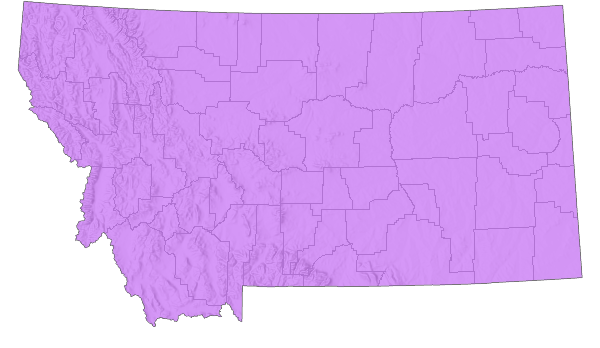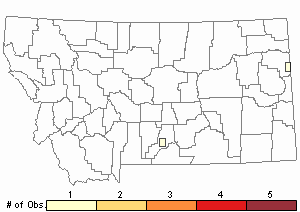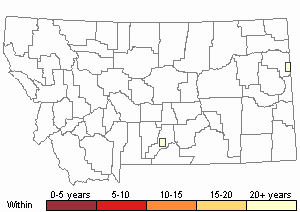View in other NatureServe Network Field Guides
NatureServe
Montana
Utah
Wyoming
Idaho
Wisconsin
British Columbia
South Carolina
Yukon
California
New York
Striped Ground Cricket - Allonemobius fasciatus
General Description
The following is taken from Fulton (1931), Alexander and Thomas (1959), Vickery and Kevan (1985), Bland (2003), and Himmelman (2009). The body color is dark brown, reddish brown to dull black with light buff brown stripes bordered ventrally with a dark strip on the lateral sides of the wings (tegmina). Black is more common in individuals at more northern latitudes. The head is not partially retracted into the front of the pronotum as occurs in
Allard's Ground Cricket (
A. allardi), and is striped with 4 or 5 yellowish to dark colored longitudinal dark stripes, hence its common name.
Calling song description The following comes from Alexander and Thomas (1959), Fulton (1931 and 1933), Elliott and Hershberger (2007), Himmelman (2009), Morris and Morris (2004), and Walker's SINA website (2020). The
Allard's Ground Cricket (
A. allardi), and the Striped Ground Cricket,
A. fasciatus, are persistent singers both day and night. As in other crickets, the songs are produced only during the closing of the wings. The song has been described as “a regular series of high-pitched, metallic chirps or buzzes given at a rapid rate (other authors describe it as “a high, burry chit…chit…chit”). The pulse rate depends upon the ambient temperature. When singing, the male raises his wings (tegmina) about 45-degrees to the body, and spreads and vibrates them. Like most crickets, the right tegmen is the uppermost and the two tegmina are not identical. The right is darker in color and has a rougher surface. The left possesses only a narrow-raised edge on the inner margin where it comes in contact with the stridulatory file of the right tegmen. There are two variations of the mating song.
Phenology
This species overwinters in egg stage. Nymphs hatch in June, maturing to adults by mid-July to early August, to late September. They usually disappear before the first frost (Vickery and Kevan 1985).
Diagnostic Characteristics
The following is comes from Fulton (1931), Alexander and Thomas (1959), Vickery and Kevan (1985), and Bland (2003). The body length for males is 7-10 mm and females 8-11 mm. The pronotum (thorax) is barrel-shaped, with the head and dorsal anterior and posterior margins are equal in breadth for short-winged (brachypterous) forms (the most common in this species). Long-winged forms (macropterous) can occur where the posterior pronotum edge is wider. In female short-winged forms, the tegmina covers about half of the abdomen length, and in males it covers about two-thirds of the abdomen. In long-winged females, the tegmina extends to the tip of the ovipositor, and the hind wings of males extend beyond the tip of the abdomen and cerci. The female ovipositor is 5.9 (<6)-10 mm. It is nearly straight with a slight upward curve, the tip is not swollen but tapering, and the dorsal teeth are short and evenly spaced. The male stridulatory vein is always less than 1 mm long (commonly less than 0.9) and less than one-third as long as the width of the head behind the eyes. It possesses 106-128 teeth with an average of 117. Two middle tibial spurs are unequal (see red arrow in drawing).
This species is easily confused for small Field Crickets,
Gryllus spp., but the two Montana
Allonemobius species are much smaller. However, they too are easily confused and difficult to identify because they do not possess any single morphological character by which they can be easily separated. They can be distinguished by using combinations of such characters as length of female ovipositor, head banding intensity, and length and head width behind the eyes. Males of the species’ can be separated by measuring the length of the stridulatory vein and number of teeth on the file of the right tegmen viewed dorsally (compare “Diagnostic Characteristics” for the Striped Ground Cricket and the
Allard's Ground Cricket (
A. allardi)) (Alexander and Thomas 1959).
Species Range
Montana Range
Range Descriptions

 Native
Native
Range Comments
The Striped Ground Cricket ranges from Washington, Oregon, British Columbia, eastward to New England and Nova Scotia. From the southern areas of the Canadian provinces southward to Texas in the west and West Virginia in the east. In Montana, this species has been reported in 8 counties. Of the two species found in Montana, A. fasciatus is more widely distributed in North America than Allard's Ground Cricket (A. allardi) (Vickery and Kevan 1985, Capinera et al. 2004, and Walker's SINA website 2020).
Observations in Montana Natural Heritage Program Database
Number of Observations: 6
(Click on the following maps and charts to see full sized version)
Map Help and Descriptions
Relative Density

Recency



 (Observations spanning multiple months or years are excluded from time charts)
(Observations spanning multiple months or years are excluded from time charts)
Habitat
This species prefers more moist and wetter habitats than
A. allardi, such as low-lying moist areas in grasslands, edges of ponds, streams, and wetlands (Bland 2003, Howard and Furth 1986, and Vickery and Kevan 1985).
Food Habits
The Striped Ground Cricket is omnivorous and similar to
Allard's Ground Cricket (
A. allardi). However, it appears that
A. fasciatus individuals require feeding upon an equal amount of both plant and animal matter (Vickery and Kevan 1985).
Reproductive Characteristics
Generally, the same mating and reproductive sequences as those as those of
Allard's Ground Cricket (
A. allardi). Prior to mating, the male faces the female and sings, using one of its two special mating songs, and performs a dance by jerking his body backward and forward without changing the position of his feet. Male and female touch their antennae, performing what is called antennation. The male’s genitalia are protruded, but his spermatophore does not form until a short time before mating. The male turns away from the female, drops the tegmina, and backs toward the female and at the same time raises one hind femur with the tibia closed upon it, and moves it so far forward that it is inverted. The female crawls over the top of the male and begins to bite the specialized “gift-producing” proximal spine on the tibia. This brings the female forward for the male to push his claspers into the opening between her ovipositor and subgenital plate to attach the spermatophore. The pair remain in this position for 15-25 minutes, all the time the female biting the spine. When the female leaves, the spermatophore is attached with a tube through which sperm will be delivered to her spermatheca. Later she removes it and eats it. Ground Crickets,
Allonemobius spp., produce one generation per year (Fulton 1931, Fedorka and Mousseau 2002, and Mays 1971).
Stewardship Responsibility
References
- Literature Cited AboveLegend:
 View Online Publication
View Online Publication Alexander, R.D. and E.S. Thomas. 1959. Systematic and behavioral studies on the crickets of the Nemobius Fasciatus group (Orthoptera: Grillidae: Nemobiinae). Systematic and behavioral studies on the crickets of the Nemobius Fasciatus group (Orthoptera: Grillidae: Nemobiinae). Annals of the Entomological Society of America 52(5):591-605.
Alexander, R.D. and E.S. Thomas. 1959. Systematic and behavioral studies on the crickets of the Nemobius Fasciatus group (Orthoptera: Grillidae: Nemobiinae). Systematic and behavioral studies on the crickets of the Nemobius Fasciatus group (Orthoptera: Grillidae: Nemobiinae). Annals of the Entomological Society of America 52(5):591-605. Bland, R.G. 2003. The Orthoptera of Michigan—Biology, Keys, and Descriptions of Grasshoppers, Katydids, and Crickets. East Lansing, MI: Michigan State University Extension, Bulletin E-2815. 221 p.
Bland, R.G. 2003. The Orthoptera of Michigan—Biology, Keys, and Descriptions of Grasshoppers, Katydids, and Crickets. East Lansing, MI: Michigan State University Extension, Bulletin E-2815. 221 p. Capinera, J.L., R.D. Scott, and T.J. Walker. 2004. Field Guide to Grasshoppers, Katydids, and Crickets of the United States. Ithaca, NY. Cornell University Press.
Capinera, J.L., R.D. Scott, and T.J. Walker. 2004. Field Guide to Grasshoppers, Katydids, and Crickets of the United States. Ithaca, NY. Cornell University Press. Elliott, L. and W. Hershberger. 2007. The songs of insects. New York, NY: Houghton Mifflin Harcourt. 227 p.
Elliott, L. and W. Hershberger. 2007. The songs of insects. New York, NY: Houghton Mifflin Harcourt. 227 p. Fedorka, K.M. and T.A. Mousseau. 2002. Tibial spur feeding ground crickets: larger males contribute larger gifts (Orthopter: Gryllidae). Florida Entomologist 85:324-329.
Fedorka, K.M. and T.A. Mousseau. 2002. Tibial spur feeding ground crickets: larger males contribute larger gifts (Orthopter: Gryllidae). Florida Entomologist 85:324-329. Fulton, B.B. 1931. The study of the genus Nemobius (Orthoptera:Gryllidae). Annals of the Entomological Society of America 24(2).
Fulton, B.B. 1931. The study of the genus Nemobius (Orthoptera:Gryllidae). Annals of the Entomological Society of America 24(2). Fulton, B.B. 1933. Inheritance of songs in hybrids of two subspecies of Nemobius fasciatus (Orthoptera). Annals of the Entomological Society of America 24:368-376.
Fulton, B.B. 1933. Inheritance of songs in hybrids of two subspecies of Nemobius fasciatus (Orthoptera). Annals of the Entomological Society of America 24:368-376. Himmelman, J. 2009. Guide to Night-Singing Insects of the Northeast. Mechanicsburg, PA: Stackpole Books. 160 p.
Himmelman, J. 2009. Guide to Night-Singing Insects of the Northeast. Mechanicsburg, PA: Stackpole Books. 160 p. Howard, D.J. and D.G. Furth. 1986. Review of the Allonemobius fasciatus (Orthopter: Gryllidae) complex with the description of two new species separated by electrophoresis, songs, and morphometrics. Annals of the Entomological Society of America 79:472-481.
Howard, D.J. and D.G. Furth. 1986. Review of the Allonemobius fasciatus (Orthopter: Gryllidae) complex with the description of two new species separated by electrophoresis, songs, and morphometrics. Annals of the Entomological Society of America 79:472-481. Mays, D.L. 1971. Mating behavior of Nemobiine Crickets-Hygronemobius, Nemobius, and Pteronemobius (Orthoptera:Gryllidae). Florida Agricultural Experiment Station Journal 54(2):113-126.
Mays, D.L. 1971. Mating behavior of Nemobiine Crickets-Hygronemobius, Nemobius, and Pteronemobius (Orthoptera:Gryllidae). Florida Agricultural Experiment Station Journal 54(2):113-126. Morris, G.K. and A.S. Morris. 2004. Investigation of species-specific harmonics and their role in localization in two species of Allonemobius. University of Toronto, Academia.edu.
Morris, G.K. and A.S. Morris. 2004. Investigation of species-specific harmonics and their role in localization in two species of Allonemobius. University of Toronto, Academia.edu. Vickery, V. R. and D. K. M. Kevan. 1985. The grasshopper, crickets, and related insects of Canada and adjacent regions. Biosystematics Research Institute, Ottawa, Ontario. Publication Number 1777. 918 pp.
Vickery, V. R. and D. K. M. Kevan. 1985. The grasshopper, crickets, and related insects of Canada and adjacent regions. Biosystematics Research Institute, Ottawa, Ontario. Publication Number 1777. 918 pp. Walker T.J.(ed.). 2020. Singing insects of North America. Accessed 10 February 2021. https://orthsoc.org/sina/
Walker T.J.(ed.). 2020. Singing insects of North America. Accessed 10 February 2021. https://orthsoc.org/sina/
- Additional ReferencesLegend:
 View Online Publication
View Online Publication
Do you know of a citation we're missing? Alexander, R.D. and D. Otte. 1967. The evolution of genitalia and mating behavior in crickets (Gryllidae) and other Orthoptera. Ann Arbor, MI: University of Michigan. Misc. publications, Museum of Zoology, No. 133. 69 p.
Alexander, R.D. and D. Otte. 1967. The evolution of genitalia and mating behavior in crickets (Gryllidae) and other Orthoptera. Ann Arbor, MI: University of Michigan. Misc. publications, Museum of Zoology, No. 133. 69 p. Alexander, R.D., A.E. Pace, and D. Otte. 1972. The singing insects of Michigan. The Great Lakes Entomologist 5(2):33-69.
Alexander, R.D., A.E. Pace, and D. Otte. 1972. The singing insects of Michigan. The Great Lakes Entomologist 5(2):33-69. Dethier, V.G. 1992. Crickets and Katydids, Concerts and Solos. Cambridge, MA: Harvard University Press. 140 p.
Dethier, V.G. 1992. Crickets and Katydids, Concerts and Solos. Cambridge, MA: Harvard University Press. 140 p. Forrest, T.G. 1991. Mate choice in ground crickets (Gryllidae:Nemobiinae). Florida Entomologist 74(1):74-80.
Forrest, T.G. 1991. Mate choice in ground crickets (Gryllidae:Nemobiinae). Florida Entomologist 74(1):74-80. Hebard, M. 1928. The Orthoptera of Montana. Proceedings of the Academy of Natural Sciences of Philadelphia, Vol. 80:211-306.
Hebard, M. 1928. The Orthoptera of Montana. Proceedings of the Academy of Natural Sciences of Philadelphia, Vol. 80:211-306. Himmelman, J. 2011. Cricket radio: tuning in the night-singing insects. Cambridge, MA: The Belknap Press of Harvard University Press. 272 p.
Himmelman, J. 2011. Cricket radio: tuning in the night-singing insects. Cambridge, MA: The Belknap Press of Harvard University Press. 272 p. Howard, D.J. 1983. Electrophoretic survey of eastern North American Allonemobius (Orthoptera:Gryllidae): Evolutionary relationships and the discovery of three new species. Annals of the Entomological Society of America 76(6):1014-1021.
Howard, D.J. 1983. Electrophoretic survey of eastern North American Allonemobius (Orthoptera:Gryllidae): Evolutionary relationships and the discovery of three new species. Annals of the Entomological Society of America 76(6):1014-1021. Jacobs, S.B., R.A. Byers and S.G. Anderson. 1992. Habitat and food preferences of Allonemobius allardi (Orthoptera:Gryllidae) and potential damage to alfalfa in conservation-tillage systems. Entomological Society of America 85(5):1933-1939.
Jacobs, S.B., R.A. Byers and S.G. Anderson. 1992. Habitat and food preferences of Allonemobius allardi (Orthoptera:Gryllidae) and potential damage to alfalfa in conservation-tillage systems. Entomological Society of America 85(5):1933-1939. McNeal, D.L. and C.M. Grozinger. 2020. Singing in the suburbs: point count surveys efficiently reveal habitat associations for nocturnal Orthoptera across an urban-to-rural gradient. Journal of Insect Conservation 24:1031-1043.
McNeal, D.L. and C.M. Grozinger. 2020. Singing in the suburbs: point count surveys efficiently reveal habitat associations for nocturnal Orthoptera across an urban-to-rural gradient. Journal of Insect Conservation 24:1031-1043. Sater, S. 2022. The insects of Sevenmile Creek, a pictorial guide to their diversity and ecology. Undergraduate Thesis. Helena, MT: Carroll College. 242 p.
Sater, S. 2022. The insects of Sevenmile Creek, a pictorial guide to their diversity and ecology. Undergraduate Thesis. Helena, MT: Carroll College. 242 p. Scott, R.D. 2010. Montana Grasshoppers, Katydids, and Crickets A Pictorial Field Guide to the Orthoptera. MagpieMTGraphics, Billings, MT.
Scott, R.D. 2010. Montana Grasshoppers, Katydids, and Crickets A Pictorial Field Guide to the Orthoptera. MagpieMTGraphics, Billings, MT. Tennis, P. 1983. Survivorship, pattern and habitat structure of field crickets (Orthoptera:Gryllidae) in two old fields. Environmental Entomology 12(1):110-116.
Tennis, P. 1983. Survivorship, pattern and habitat structure of field crickets (Orthoptera:Gryllidae) in two old fields. Environmental Entomology 12(1):110-116. Vickery, V.R. and D.E. Johnstone. 1970. Generic status of some Nemobiinae (Orthoptera: Gryllidae) in northern North America. Annals of the Entomological Society of America 63(6):1740-1749.
Vickery, V.R. and D.E. Johnstone. 1970. Generic status of some Nemobiinae (Orthoptera: Gryllidae) in northern North America. Annals of the Entomological Society of America 63(6):1740-1749.
- Web Search Engines for Articles on "Striped Ground Cricket"
- Additional Sources of Information Related to "Insects"





